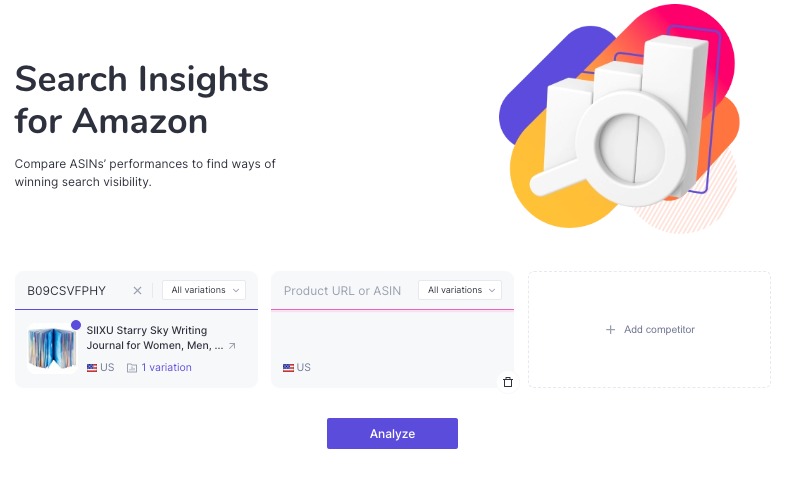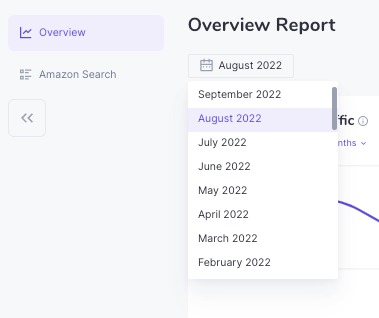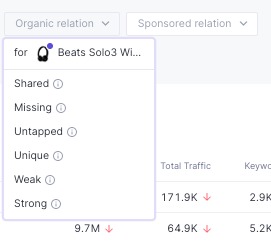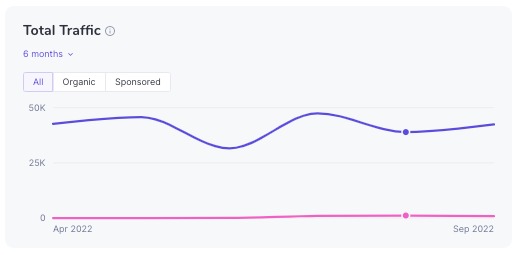The Search Insights for Amazon app helps you increase your product’s visibility in Amazon search through competitive insights. With it, you can:
- Analyze up to three products simultaneously by ASIN or URL
- Identify top Amazon keywords by traffic
- Compare product reach
- Compare Amazon search positions by keyword
How Search Insights for Amazon Can Help You
Created for new and experienced sellers alike, Search Insights for Amazon provides the competitive insights you need to optimize your product pages more effectively.
With it, you can analyze any Amazon product—your own, a top competitor’s, or a comparable product—to understand exactly how customers search for it and how much organic traffic that product page receives from each keyword.
You can uncover details like:
- Which keyword drove the most traffic to that product page
- Which Amazon SERP features it won, including Amazon’s Choice, Editorial Recommendations, Top Rated, Today’s Deals, and more
- Amazon search performance over time
Then, you can increase your product’s visibility by incorporating these insights into your Amazon SEO strategy.
Accessing Search Insights for Amazon
Search Insights for Amazon is available with limited access for free to all registered Semrush users.
You can also purchase the app with unlimited access for $19.99 per month in the Semrush App Center.
Here are the features of each version:
Free version:
- No monthly subscription
- Access to the Overview Report
- Demo product reports to preview paid version functionality
Paid version:
- Overview Report
- Amazon Search Report
To learn more about the Semrush App Center, including how to purchase apps, visit our App Center guide.
How To Use Search Insights for Amazon
With Search Insights for Amazon, you can analyze the Amazon search performance of up to three products at a time.
To start your search, first navigate to the Search Insights for Amazon app and enter the URL or the ASIN of any product in the Amazon US marketplace. Here, you can also specify whether you want to research all variations of a product or limit your search to that exact ASIN.

You can find any product’s ASIN on its Amazon product page, under “Additional Information.”

Once you’re happy with your search criteria, click “Analyze.”
As you explore the tool, the products you search for will be displayed in tiles at the top of the page. Here, you can find information like:
- Which color represents that product in charts and graphs
- ASIN number
- Product name and image

You can use these tiles to update your search at any time. For example, you can:
- Add a new product to your search by clicking “add competitor” and entering the ASIN or URL
- Replace a product in your search by clicking the “x” in the corresponding tile and entering a new ASIN
- Remove a product from comparison by clicking the bin icon
- Update your settings to include or exclude variations
When you make any changes to your search, the data displayed in the app will update accordingly.
Overview Report
The Overview Report provides a high-level view of a product’s Amazon search performance during a particular month and over time.
The month being analyzed is displayed at the top of the page, just below the report name. To change it, simply click on it and use the drop-down menu to select your preferred date.

Once you select a new date, each widget will update accordingly.
The Overview Report contains four widgets:
- Amazon Search Traffic
- Top Keywords by Traffic
- Total Reach
- Reach by Channel
The Amazon Search Traffic widget displays the estimated number of customers who visited a product page from search, over a period of six or twelve months surrounding the selected month.
The example below shows a six-month period around August 2022 (indicated on the graph by a dot):

To view a different six- or twelve-month period, use the drop-down menu. You can find it just below the widget name.
To the right of Amazon Search Traffic is Top Keywords by Traffic.

This chart lists the top five keywords driving traffic to the analyzed products during the selected month.
If you click the “Go to Amazon Search” button, you’ll be directed to the app’s Amazon Search Report, which is accessible to paid users.
On the next row, you’ll find “Total Reach” and “Reach by Channel.”

Total Reach is the sum of all keyword search volumes associated with the selected product listing. This represents the total number of customers that could potentially discover the analyzed product over a six- or twelve-month period. The line graph shows the trend across the entire period. The total positive or negative change in reach is shown in the top right corner of the graph.
Like the Search Traffic graph, the data is color-coded by product, and the analyzed month is indicated by a dot.
Please note that the selected period for Total Reach (six or twelve months) will align with your selection under Amazon Search Traffic. Therefore, if you change this setting, the above graph will also update.
To the right of the graph is Reach by Channel. This chart breaks out each product’s potential reach into two categories: Amazon Search and additional channels. The up or down arrow beside each figure indicates the positive or negative trend for that month.
If you click on the Amazon Search channel, you’ll be directed to the Amazon Search Report. If you click on the additional channels (shown as “3 more channels” in the example above), you will be directed to the Traffic Insights for Amazon Overview Report.
Amazon Search Report
The Amazon Search Report analyzes product performance on Amazon in detail.
Here, you can learn more about a product’s reach, traffic, and the keywords it ranks for during one month or over a six- or twelve-month period.
By default, this report will analyze all rankings for the products you’re currently searching for. However, you can use the menu to filter your search results.

As in the Overview Report, you can click the date to select a new month to analyze.
The All Rankings/Organic/Sponsored filter allows you to narrow your search to either organic or paid traffic.
With the keyword search filter, you can filter your data containing the specified term. For example, if you enter “headphones” here, the app will report only on keywords containing that word.
“Volume” shows data for keywords whose monthly searches fall within the specified range.
Similarly, if you filter by Traffic, you’ll see data for keywords that deliver a specified amount of traffic to the analyzed product page.
The Organic and Sponsored relation filters focus on competitive keyword data. Specifically, they compare the first product on your list (the leftmost tile) to the other two, if any. If you want to focus on a different product, you’ll need to update your search so that the one you want to study is listed first.

Relation filters include:
- Shared: keywords all products rank for
- Missing: Keywords your main product does not rank for, but the others do
- Untapped: Keywords your main product does not rank for, but at least one other does
- Unique: Keywords only your main product ranks for
- Weak: Keywords your main product ranks lower for
- Strong: Keywords your main product ranks higher for
Other search filters include:
- Ranks in SERP features (e.g., an Amazon’s Choice, Editorial recommendation, or similar feature)
- Features on SERP (meaning the keyword displays SERP features, regardless of whether the analyzed products rank there)
- Organic or sponsored position range
- Number of competitors
Select any filters from the menu to customize your report, and each widget will update accordingly.
The Amazon Search Report includes five widgets:
- Summary
- Reach
- Total Traffic
- Keywords
- Keyword Details
First, Summary shows an overview of the data included in the report.

Here, you’ll find:
- The products you searched for and their representative colors
- Each product’s reach, total traffic, and number of keywords for that month
Next are the Reach, Total Traffic, and Keywords charts.

These are line graphs showing their respective trends for six- or twelve-month periods:
- Reach: The amount of people who potentially could have discovered each product
- Total Traffic: The amount of people who actually visited the product page
- Keywords: The number of keywords delivering traffic to a product page
Use the drop-down menu to update the date range. This selection impacts all three charts. For example, if you select 12 months for Reach, the Total Traffic and Keywords charts will also update.
Finally, Keywords Details compares each product’s performance on all the keywords they rank for. Click “Export to CSV” to download it.

This chart includes the following data for each keyword and product:
- Keyword search volume
- Keyword Difficulty
- SERP features (these are shown in gray if they appear for that keyword but neither product ranks for it, or are colored according to the winning product)
- Organic position
- Sponsored position
- Total traffic
- Number of competitor products
The Keyword Difficulty metric here is especially useful and can help you assess the amount of effort it might take to rank in organic search results for a particular keyword. In order to display that metric the app processes a complex of various essential data on factors that can influence the rankings such as traffic, reviews and rating, volume, number of products for keywords in search results, etc.
The higher the percentage, the harder it will be to achieve high rankings. The difficulty percentage for each keyword is as follows:
- Very hard (85–100%)
- Hard (70–84%)
- Challenging( 50–69%)
- Possible (30–49%)
- Easy (15–29%)
- Very easy (0–14%)
To the right of each keyword is an arrow. If you click this arrow, you’ll be directed to the Keyword Report for that term.
Keyword Report
The Keyword Report is a subset of the Amazon Search Report that analyzes one keyword in detail. As such, it can only be accessed in two ways:
- By clicking on a keyword in the Keyword Details list
- By clicking the arrow beside an entry in Keywords Details
It’s made up by a header and six widgets:
- Summary
- Keyword Volume
- Total Traffic
- Organic Position
- Sponsored Position
- Top Competitors

First, the header shows basic information about the keyword, including the month analyzed, search volume, and all SERP features that appear in the results.
Additionally, by clicking “Close” on the right or “Back to Amazon Search” on the left, you can return to the Amazon Search Report.

Next, the Summary chart recaps the information you’ll find in the rest of the report, broken out by product. This includes:
- SERP features won
- Organic and sponsored position
- Total traffic won
- Organic traffic (total, search, and SERP features)
- Sponsored traffic (total, search, and SERP features)
Next, you’ll see four line graphs. The first, Keyword Volume, analyzes the total search volume for that keyword. The other three, Total Traffic, Organic Position, and Sponsored Position, show data broken out by product.

Each of these graphs functions similarly to the others throughout the app:
- Analyzed month is indicated by a dot
- Shows six- or twelve-month periods
- Selecting a new period duration will change all of the charts
- Color-coded by product (where applicable)
The Total Traffic chart also has organic and sponsored filters.

These filters will update Total Traffic only and have no impact on the other three charts.
Finally, the Top Competitors chart lists all products competing on that keyword.

Here, you’ll learn:
- The total number of competitors
- ASIN
- Product name
- SERP features won for each product
- Organic search position
- Sponsored position
- Total traffic earned from this keyword
The arrow beside each ASIN links directly to the product page on Amazon.
Once you’re finished with this report, click either “Close” or “Return to Amazon Search” at the top of the page to exit.
If you have any questions about the Search Insights for Amazon app, please email us directly at ecommerce-apps@semrush.com.